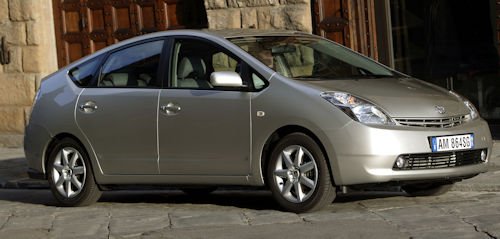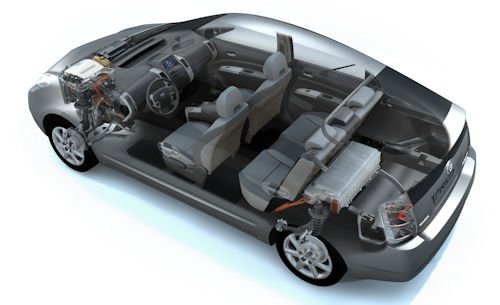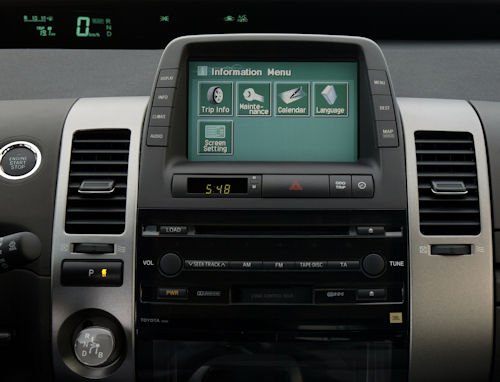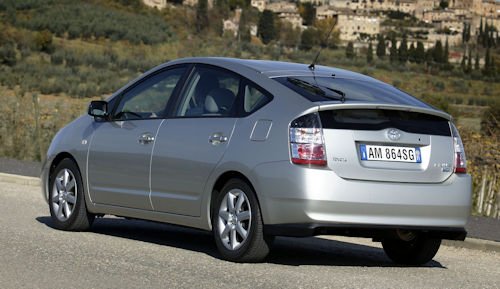Toyota Prius Prius II (2nd generation)
 |
|
|
Manufacturer |
Toyota |
|
Production |
2003 to 2009 |
|
Class |
Motor Car |
|
Body style |
5-door lift back |
|
Layout |
Front-engine, front-wheel-drive |
|
Platform |
Toyota MC platform |
|
Engine |
|
|
Transmission |
1-speed planetary gear |
|
Hybrid drivetrain |
Power-split hybrid |
|
Wheelbase |
2,700 mm (106.3 in) |
|
Length |
4,450 mm (175.2 in) |
|
Width |
1,725 mm (67.9 in) |
|
Height |
1,490 mm (58.7 in) |
|
Curb weight |
1,317 kg (2,903 lb) |
In late 2003, a new Prius appeared, which differed both in appearance and in technology from its predecessors. The headlights are pulled further up; the rear has been transformed into a hatchback. The THS has given way to the Hybrid Synergy Drive (HSD) marketed THS-II. In autumn 2005, a discreet facelift was performed.
While the new car is instantly as an evolution of the original Prius, at 4,450 mm it is 135 mm longer than its predecessor, so the new model asserts itself as a true D-segment car. Key to this is the wheelbase, which has been extended by 150 mm to 2700 mm. Aerodynamics play a significant role in improving fuel economy and performance, and the new Prius captures a leading Cd of 0.26. The underside is as smooth as possible, playing a significant role in reducing overall drag and improving high-speed stability. The suspension, developed from the Avensis model's MacPherson struts at the font and the Corolla's torsion-beam rear set-up, while aluminium components such as brakes and front suspension decrease unsprang weight, benefiting handling and comfort.
The US marketed Prius differs in technical details from the model available in the rest of the world. So, this is equipped with a CHSS (Coolant Heat Storage System abbreviation). Before starting, the gasoline engine is warmed up by the warm cooling water held in the reservoir, which shortens the emission-rich warm-up phase. Due to the gas recirculation and vapor recovery system not used in the USAAs with the NHW11, the fuel tank is equipped with a flexible bladder that minimizes evaporation emissions. At the rear wheels, the US models are equipped with drum brakes that are sufficient for the limited top speed. The European Prius can - subject to conditions - additionally triggered by the user at the touch of a button in the EV mode in which the car is moved only with the help of electrical energy from the NiMH battery. The car does this automatically whenever the controller thinks it makes sense.
The gasoline engine operates with valve timing, in which the intake valves close very late and thereby a portion of the mixture is returned to the intake tract . Therefore, despite a mechanical compression ratio of 13: 1 , the engine can be run on standard premium grade gasoline. The process called Atkinson cycle increases the efficiency.
The new Prius is the first in the world to rely on an entirely electric active safety package, including power steering and the world's first by-wire braking system with an entirely electric set-up (excluding the backup circuit). ABS, EBD and a new version of the Vehicle Stability Control system, called
VSC+ ,The VSC+ works together with the electric power steering, acting in unison when an unexpected situation occurs. As a result, it is possible to achieve a much quicker vehicle reaction time, which will prove crucial in avoiding potential accidents.

The Prius has a power-split transmission in which the moments of the gasoline engine and the electric motors are distributed to the front wheels via a planetary gear . The gear ratio and thus the speed of the gasoline engine is controlled by means of the generator and the electric motors purely electrically and completely continuously. The acceleration behaviour therefore corresponds to a car with continuously variable transmission ( CVT ).
In addition to visual changes, a modified chassis tuning and a stiffer frame construction, the facelift of the 2006 model year introduced the option of the reversing camera with parking assistant. A horizontally split rear window had before the Prius the Lamborghini Espada and the Honda CRX in the second generation. The world's first electric inverter air-conditioning improves fuel efficiency and maintains cabin temperature, even with engine off, as it runs from an independent power source, engine efficiency is not compromised.

The full-map DVD-based navigation touch-screen and is equipped with powerful search capabilities that can incorporate points of interest, telephone numbers, postal code or even coordinates. The touch screen also features Bluetooth technology. Drivers with a Bluetooth-enabled mobile, simply select it from the central display and use touch-screen to dial. Steering wheel controls start and end calls with simple hands-free communication.
Consumption test
A more powerful 1.5-litre petrol engine works together with the more efficient electric motor to deliver a performance the electric motor is now more
powerful than most 1.0- to 1.2-litre combustion engines and at 400Nm from 0-1 ,200 rpm, the Prius model's torque figure surpasses that of V6
diesels. Because fie hybrid's advanced control Stern uses electric motor as the main power source, it displays exceptional smoothness. Acceleration is power, especially from 50-80 km/h, while noise and vibration are minimal. For the first time ever in a hybrid car, the driver can use the EV (Electric
Vehicle) driving mode simply by pressing a button installed in the fascia. This allows the exclusive use of the electric motor to power the vehicle,
producing zero emissions and very low noise.
The standard consumption for the Prius II is noisy factory specifications 4.3 litres of unleaded premium gasoline per 100 km distance, this has a CO 2 emissions of 104 g / km result. In the so-called "CO 2 marathon", the ADAC determined a practical consumption of 5.8 l / 100 km, which means a CO 2 emission of about 136 g / km, which makes it the best in terms of CO 2 efficiency.
The CO 2 emission measured in the "Ecotest" on the ADAC test bench was 119 g / km and the fuel consumption was 5.02 l / 100 km. The combustion of one litre of gasoline produces about 2,360 g of CO 2 .

Technical
-
Engine
Type - L4, normally aspirated
Cylinder head material - Aluminium alloy
Engine block material - Aluminium alloy
Fuel type - 95 Octane
injection type - Sequential multiport EFI
Engine size cc - 1 ,497
Bore x stroke mm - 75.0 x 84.7
Compression ratio :1 - 13.0Electric motor
Type - Synchronous, permanent magnet
Rated voltage V) - 500
Max. power(kW/ m) - 50@1200-1540
Max. torque NM/ m - 400@0-1200
Weight (kg) - 104Battery pack
Type -Panasonic EV Energy
Nominal voltagee (V) - 201.6
Number of modules - 28
Capacity (Ah) - 6.5 (3h)
Weight (kg) - 39© Motor car History
-Note: More Specifications and Repair Manuals available for registered users-
